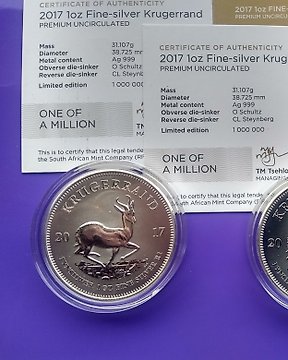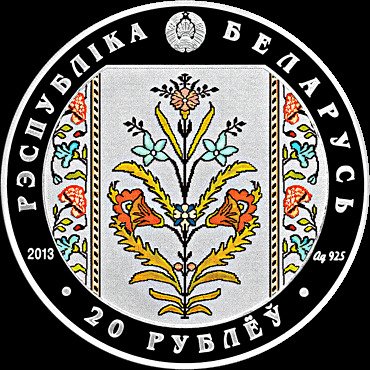
Sudafrica. 1 Rand 2017 50th Anniversary - Krugerrand - 2x1 Oz (.999) (Senza Prezzo di Riserva)
N. 82972493

N. 82972493

Name (ENG): The Belts of Slutsk. Collecting
Series: Coins of the Belts of Slutsk Series
Denomination (BYN): 20
Metal: Ag 925
Weight (gram): 33.62
Quality: PROOF
Diameter: 50.00
Issue Limit, pcs.: 7,000
Issue Date: 2013
Net pure one ounce (31.1 grams) silver coin. Includes original certificate of authenticity and information booklet.
Collecting
In the late 18th and early 19th centuries, the wear by the noblemen of traditional kuntusz dress in the territory, which after the partition of the Polish-Lithuanian Commonwealth (Rzeczpospolita) fell to the Russian Empire, was perceived as demonstration of disloyalty to reign. Over time, the traditional noblemen’s dress was ousted by the European clothes and kuntusz belts, as an accessory of dress, survived their usefulness. They were kept in chests together with other family heirlooms, presented to Roman Catholic Churces to decorate liturgical vestments, and used as a means of hording because gold and silver were contained therein.
People started to realize that the belts of Slutsk are unique pieces of art in the second half of the 19th century only. At first, kuntusz belts were kept in private collections and later on many of them were donated to the collections of the national museums.
A high-class collection of the belts of Slutsk gathered in the early 20th century by the leading Belarusian collector and archeologist Ivan Lutskevich (1881-1919) formed a part of the collection of Ivan Lutskevich Belarusian Museum in Vilnius and at the end of the 1940s passed into the collection of the National Museum of Lithuania. A big collection of the high-quality belts produced by persiarnya of Slutsk of the well-known Russian patron of arts P.I. Shchukin (1853-1912) was donated, according to his will, to the Imperial Historical Museum (at present, the State Historical Museum in Moscow). The collection of 32 belts of Slutsk and Slutsk type, which were kept till 1939 in the Radziwills’ palace in Niasvizh and then in the Art Gallery (at present, the National Art Museum of the Republic of Belarus), was lost during World War II. Several belts were kept in the collection of the pre-war Belarusian State Museum.
Nowadays, the most significant collections of the belts of Slutsk are exhibited in the museums of Poland, Russia, Lithuania, and Ukraine. As of 2005, there are 11 belts with complete composition in the collections of seven Belarusian museums, of which five were produced in Slutsk and six in the other weaving centres of the 18th century.
The obverse had: the image of a fragment of the reversible belt produced by the manufactory of Slutsk.
In the corner there is the marking “SLUCK”. Coloured silk, gold and silver threads, weaving. The colours are: golden yellow, pink, light blue, light green, pale, orange, silver grey, blue, and brown. At the belt-end there is a floral motive in the form of a stylized spring of flowers with leaves. The bunch has a pair-wise symmetrical placement relative to the central axis. The flowers at the top of the springs resemble cornflowers.
The belt is exhibited in the National Museum of History and Culture of Belarus.
The "Coins of the Belts of Slutsk" series contains 5 different coins:
- Nobleman's Dress
- Weaving
- The Radziwills
- Markings
- Collecting
This coin was personally purchased by the seller at the National Bank of the Republic of Belarus in Minsk, Belarus. To prevent environmental contamination, the coin has never been taken out of its capsule. Any scratches or irregularities are solely on the surface of the capsule.
Come fare acquisti su Catawiki
1. Scopri oggetti speciali
2. Fai l’offerta più alta
3. Paga in tutta sicurezza